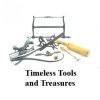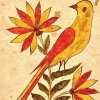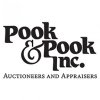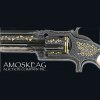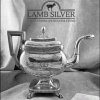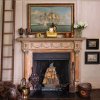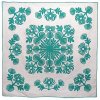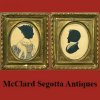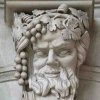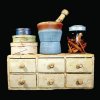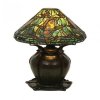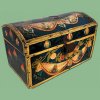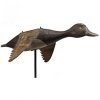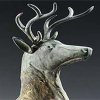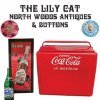The 2017 Penn Dry Goods Market
May 20th, 2017
Pennsburg, Pennsylvania
“This is the gathering of the clan,” said Newbold “Newbie” Richardson, an Alexandria, Virginia, costume and textile appraiser, conservator, and exhibition consultant, while greeting her colleagues, many of them museum curators and authors of books on needlework and textiles, at the fifth annual Penn Dry Goods Market at the Schwenkfelder Library and Heritage Center on Seminary Street in Pennsburg, Pennsylvania, held May 19 and 20.
Collectors and scholars came from all parts of this country to attend lectures on samplers of Maryland and Delaware, signature quilts, and Moravian needlework and headwear. Laurel Horton spoke about Dresden embroidery on early southern white counterpanes, focusing on a body of work in Kentucky and Tennessee. Others gave talks on coverlets and the use of blues in African American quilts. Some of the speakers are curators; others are independent researchers.
Winterthur curator Linda Eaton spoke about women’s needlework accomplishments and how the greater artistic society viewed those works. Were they art or were they craft? In the 18th century, the distinction between art and craft was not made; the art and mystery of the trades were synonymous. The distinction gets wider as the centuries move on.
Some women did succeed in getting a measure of fame as artists rather than as craftswomen-embroiderers. One of those was Mary Linwood. Kathleen Staples, an independent scholar from Greenville, South Carolina, said Linwood crossed the divide. She made embroidered copies of famous people as depicted in paintings.
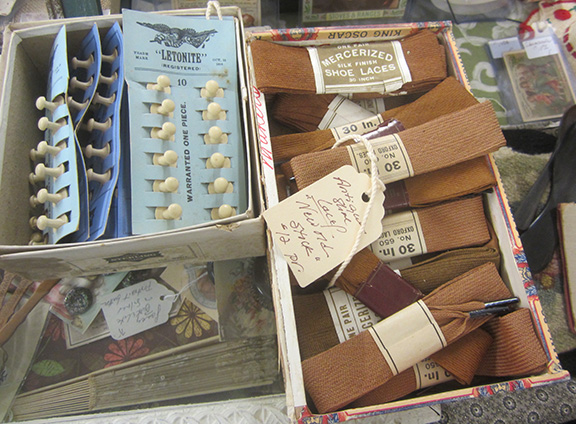
Pictured is some of the new old stock from Linda Sarubin and Carroll Swam of The Gatchellville Store, New Park, Pennsylvania. The mercerized shoelaces were $12 a pair, the collar buttons from 1896 were $12 a pair, and the cards of hooks and eyes and cards of tiny buttons were $12 per card. Cards of Star snaps were $10 per card.
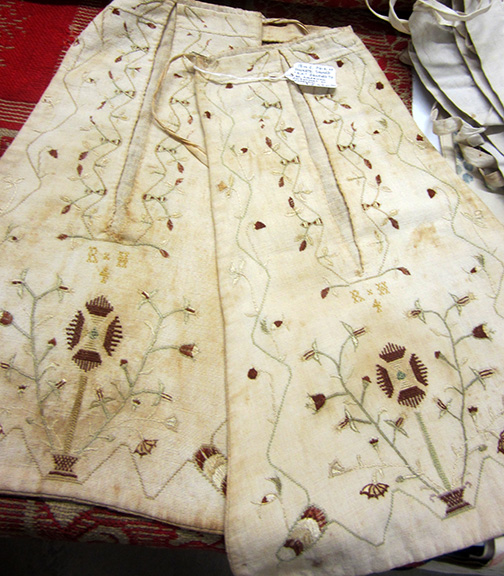
Phyllis Carlson and Timothy Stevenson of Manchester Center, Vermont, asked $2650 for this pair of American embroidered pockets on homespun, signed “RH.”
Candace Perry, curator of collections at the Schwenkfelder Museum, spoke about the rare Schwenkfelder townscape wool embroideries that show what the town of Pennsburg looked like in the 1840s and 1850s—the very town where 24 dealers had set out their wares in the museum that commemorates these early settlers.
The dealers turned much of the museum space into an old-fashioned notions store with all the supplies for sewing, quilting, and embroidery, and the finished products from the 18th, 19th, and early 20th centuries for sale. Yard goods, buttons, snaps, hooks and eyes, shoelaces, ribbons, bindings, sewing tools, and sewing boxes and baskets were offered, as were the finished products: shoes, clothes, quilts, pillowcases, samplers, rugs, potholders, and more—the list is long.
There were some glorious quilts, a masterpiece overshot coverlet, and the largest Grenfell Log Cabin rug known. Yard goods ranged from collections of early 19th-century chintz and homespun to 20th-century Japanese blue cottons. There was new old stock of buttons, hooks, snaps, shoelaces, and even unworn very old shoes, and there was a selection of well-worn boots and dancing slippers, most in children’s sizes. Clothes ranged from a little boy’s vest and very young girls’ hoops to go-to-meeting girls’ clothes and their mothers’ maternity dresses.
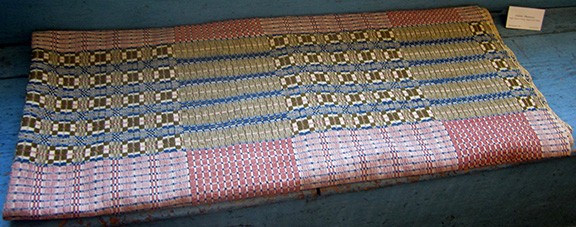
Colette Donovan of Merrimacport, Massachusetts, said this was the finest overshot coverlet she has owned in 34 years in business. The colors are avocado green, indigo blue, and taupe-rose. In near-perfect condition, reversible, and possibly dating from the 18th century, it was available for $2700.
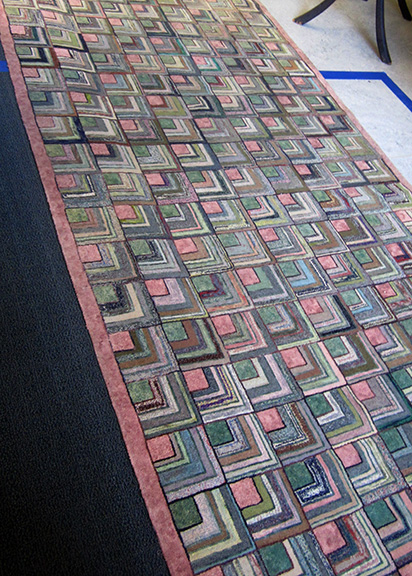
Made in the 1920s and in pristine condition, this largest Grenfell Log Cabin rug, approximately 4' x 7', was $8500 from Colette Donovan.
A good crowd came when the show opened at 10 a.m. on Friday, and a group tour of 16 who called themselves “The Stitchers,” put together by Susan Greening Davis, a specialist in needlework workshops and international tours, stayed for three days. The official name of the tour is Still Stitching, and the number of participants was limited because Davis could get only eight double rooms at the Holiday Inn in Quakertown. The women on tour arrived on May 17, got an extra lecture on May 18, and left on May 21; the cost with all overnights, meals, and lectures included was $1275. It sold out, and all the women said they wanted to come back next year. They attended all 11 lectures (six on Friday and five on Saturday), shopped, and had their own show-and-tell at the motel after the show closed on Saturday.
The museum members were there to help in a number of ways, including the food tent. The museum’s executive director, David Luz, made the chicken corn soup—a big seller with rave reviews. Volunteers helped in the museum shop and helped dealers set up and pack out; there were no porters at this show.
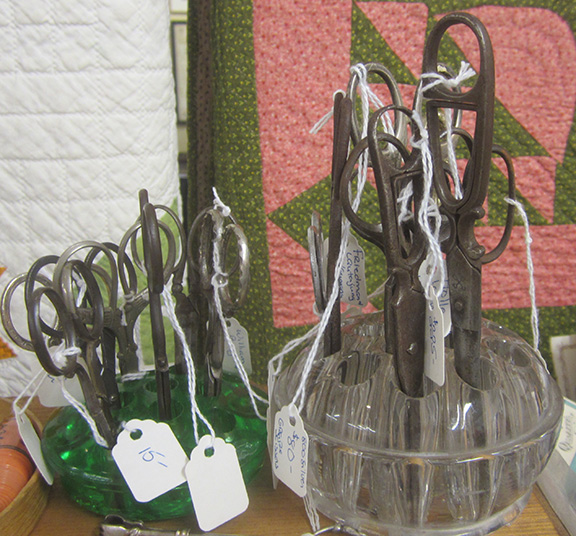
Shannon Dalton of Brick, New Jersey, who shared a stand with Diane Cucci of Point Pleasant Beach, New Jersey, used flower frogs to display a collection of scissors, priced from $15 to $80 each
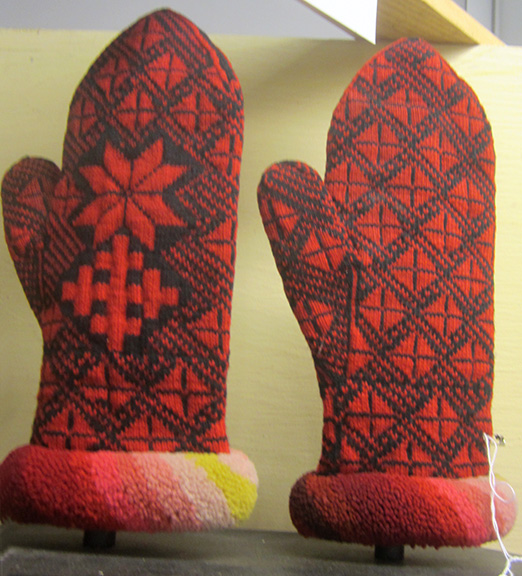
David Tuttle asked $225 for the pair of Hudson Bay mittens.
Everyone who came had a good time and learned about the Schwenkfelders, followers of Caspar Schwenkfelder von Ossig (1489-1561), a German nobleman from Silesia (now Poland) who attracted followers during the Protestant Reformation. A split with Martin Luther led to their persecution, and, finally, from 1734 to 1737 most of the followers fled and settled in southeastern Pennsylvania. On September 24, 1734, they held their first Day of Remembrance, which is celebrated each year; it’s the oldest continuously observed day of thanksgiving in the U.S. The Schwenkfelder Library and Museum houses more than 50,000 books, records, and artifacts, all freely open to scholars, researchers, and the visiting public.
Every year, the Penn Dry Goods Market seems to get better, as dealers with higher quality material are added. Museum curators come and take memos on quilts and samplers, so it may be months before dealers know how well they did. Preshow dealer-to-dealer selling was brisk. Generally, as at all shows this spring, selling was sluggish for some and great for others. Dealers who had hoped for more sales blamed it on the political situation in Washington, D.C.
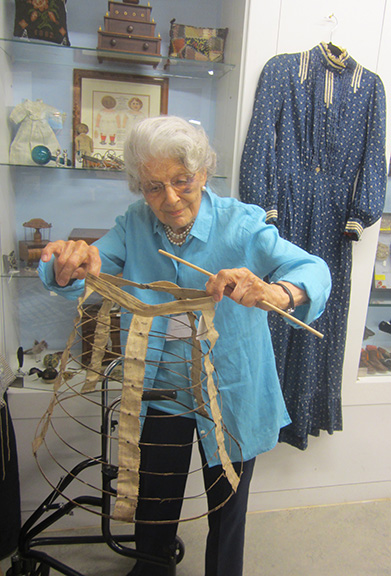
“This hoop would fit a two-year-old,” said Tex Johnson, now 98.
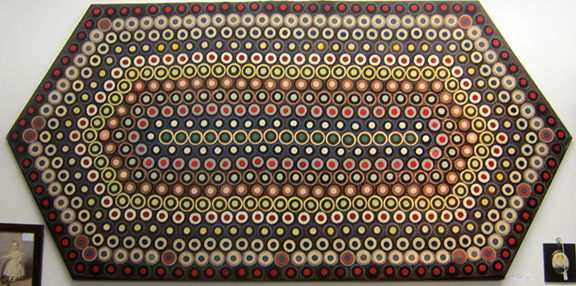
Rose B. Berry of Richmond, Virginia, asked $1200 for this large penny rug, about 5' wide, made in New Jersey.
“Sales are always down in election years,” said one longtime dealer. “After the election, the market usually picks up, but that has not happened this time. The very best is always in demand if the right people come to the show, and people buy inexpensive things, but the middle market, which is our bread and butter, is suffering. The middle class does not have extra money to spend.”
 The Penn Dry Goods Market is one of those small, focused shows with reasonable booth rent and a dedicated following that will continue to build a tradition. Those passionate about textiles manage to find it at a country crossroads about an hour from suburban Philadelphia. Its May dates always interfere with weddings and graduations, but at no time does the countryside look more beautiful, with wild phlox and buttercups in the fields, and irises and rhododendrons in full bloom in the gardens.
The Penn Dry Goods Market is one of those small, focused shows with reasonable booth rent and a dedicated following that will continue to build a tradition. Those passionate about textiles manage to find it at a country crossroads about an hour from suburban Philadelphia. Its May dates always interfere with weddings and graduations, but at no time does the countryside look more beautiful, with wild phlox and buttercups in the fields, and irises and rhododendrons in full bloom in the gardens.
This spring, the Schwenkfelder Museum exhibition Bloomin’/ Blumen: Flowers in Pennsylvania Textiles and Folk Art appropriately featured quilts, painted china, painted flower pieces on paper, and fraktur from the museum’s collection. The exhibition continues until September 30.
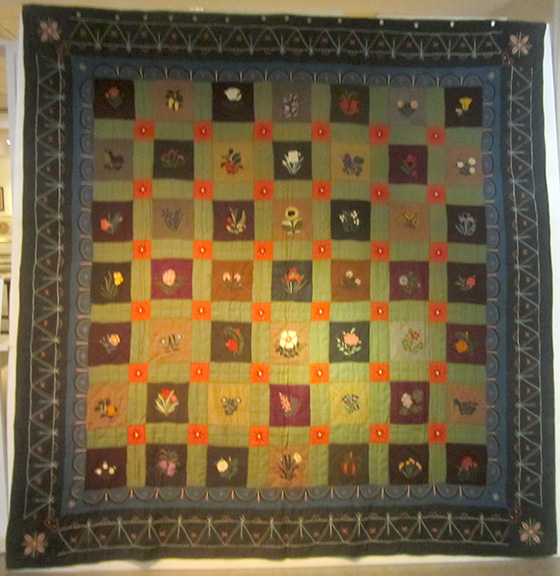
This Schwenkfelder flower quilt is from the museum exhibition Bloomin’/Blumen: Flowers in Pennsylvania Textiles and Folk Art, which will be on view through September 30 at the Schwenkfelder Library and Museum in Pennsburg, Pennsylvania.
No other show has more devoted and knowledgeable managers than textile historian Kathy Lesieur and Schwenkfelder Museum curator Candace Perry. For more information, call (215) 679-3103, or visit the website (www.schwenkfelder.org).
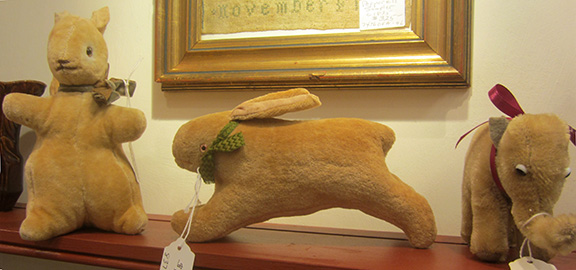
The squirrel was $135, the velveteen rabbit, $145, and the elephant, $75—all from Peggy and John Bartley of Old Farm Antiques, Fleetwood, Pennsylvania.
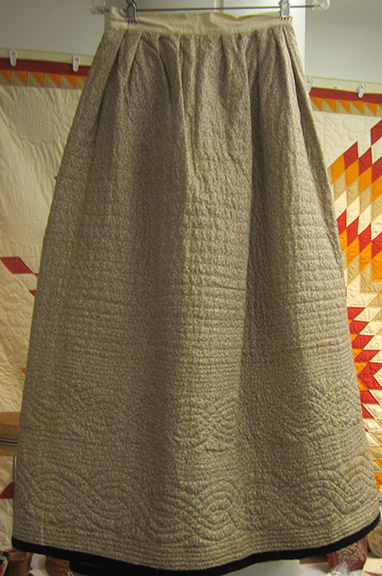
The Amish petticoat was $225 from Peggy and John Bartley.
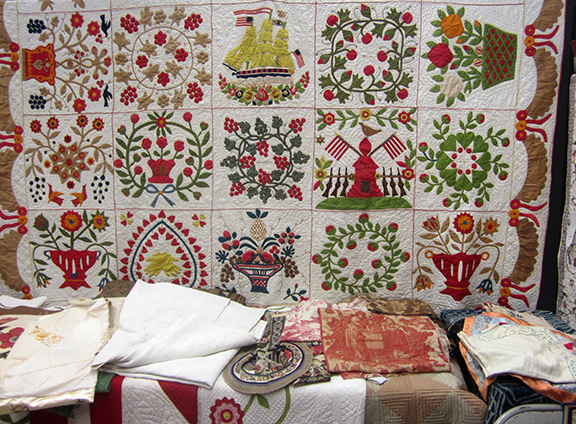
The Baltimore album quilt with a rare ship in one square and the tomb of General Ringgold, a hero of the Mexican War, in another was $42,000 from Julie Silber of Berkeley, California.
Originally published in the July 2017 issue of Maine Antique Digest. © 2017 Maine Antique Digest
